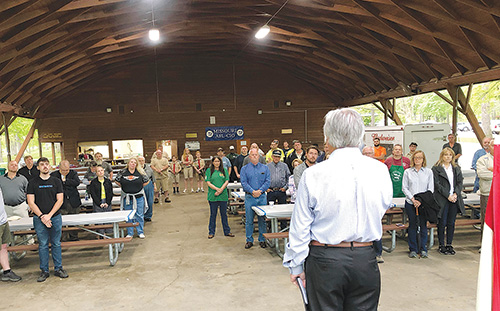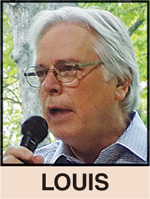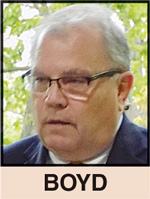
By TIM ROWDEN
Editor
Jefferson City, MO – Mourning for workers lost and recommitting to “fight like hell for the living,” union members, Scouts and working family advocates gathered at Memorial Park here April 30 for the second annual Missouri AFL-CIO Workers Memorial and BBQ.
Missouri workers remembered by their unions at the ceremony included:
• Fire Captain Mark Skeens, IAFF Local 42, Kansas City
• Fire Fighter Roger Rhoads, IAFF Local 42, Kansas City
• Ronald Pointer, Laborers (LIUNA) Local 42, St. Louis
• Matthew M. Rowen, Laborers (LIUNA) Local 264, Kansas City
 “In the words of Mother Jones, our job is to mourn for the dead today but also to fight like hell for the living,” said Mike Louis, president of the Missouri AFL-CIO. “That’s what the AFL-CIO does day-in and day-out, for all the people that come lobby with us and help us maintain our stability as a non-‘right-to-work’ state in this country, we thank all of you.”
“In the words of Mother Jones, our job is to mourn for the dead today but also to fight like hell for the living,” said Mike Louis, president of the Missouri AFL-CIO. “That’s what the AFL-CIO does day-in and day-out, for all the people that come lobby with us and help us maintain our stability as a non-‘right-to-work’ state in this country, we thank all of you.”
Attorney John Boyd, of the law firm Boyd Kenter Thomas & Parrish LLC, legal counsel to the Missouri AFL-CIO, former Missouri Workers’ Compensation judge and former acting chairman of the Missouri Labor & Industrial Relations Commission, spoke on the meaning of Workers’ Memorial Day and the unbearable cost of unsafe workplaces and working conditions for workers and their families.
 “Across our country, every day eight million public employees go to work — and too many get injured or killed, still — without the basic legal guarantee of a safe workplace,” Boyd said. “Every day, 13 workers go to work, never to return home to their families.
“Across our country, every day eight million public employees go to work — and too many get injured or killed, still — without the basic legal guarantee of a safe workplace,” Boyd said. “Every day, 13 workers go to work, never to return home to their families.
“And the families of those injured or killed bear unimaginable grief, pain and suffering, as well as a majority of the financial burden that comes with occupational injury, disease and death.”
PRICE PAID BY WORKERS AND THEIR FAMILIES
In his career as a judge and lawyer, Boyd said, he has met:
- Many workers who have suffered from a workplace injury or illness.
- Many family members who received the horrific news that someone they love is never again going to come home from work and walk through the front door.
- Many mothers, fathers, brothers, sisters, husbands, wives who have to forever go on with a hole in their heart… an emptiness that can never be filled. “I often think of these workers, of these family members, and their stories,” Boyd said, listing some of the workers and families who have left the deepest impressions on him, including:
- Travis O. and Thomas B. – Career fire fighters who breathed the toxic smoke and gasses which caused their cancer.
- Larry L. and John M. – Fire fighters who died because their inferior radios failed to make them aware of a command to go to a safe zone with imminent building collapse likely.
- Pablo P. – A meat cutter and victim of medical neglect. He bled to death one hour after being sent home from a shoulder surgery performed by a doctor he was forced to see because an insurance adjuster made the decision to conserve costs rather than seek the best care for a Missourian hurt at work.
- Jonathan P. – A construction worker, new to the job, who was shot at point blank range when an unknown assailant walked on the job site, asking him for a cigarette, then killed him, leaving Jonathan’s fiancé to now raise his child, who was born after his murder.
- Donald M. – A plumber who died in a trench collapse because a safety cage, which would have saved him was at the shop rather than the job site. A single father of a profoundly disabled child, whose wife died tragically before him, Donald’s elderly grandmother was left to care for his child, who still asks “Where is Daddy?”
GRIM STATISTICS OF A BROKEN SYSTEM
“These people are statistics which are included in annual reports prepared by Missouri’s Division of Workers Compensation,” Boyd said. “But they and the countless other Missourians who provide the daily services we take for granted, who build our roads, bridges, schools and cities, who protect our safety and care for us when we are hurting, and who nurture and teach our children –– each one has to rely on a broken system designed to be a safety net to protect them, their families, and avoid financial ruin. But they are just a number.”
Among those numbers, Boyd said:
- 103,507 Missourians reported injuries last year. “How many more go unreported if the Missourian has health insurance because they’ve heard of the problems of navigating workers’ compensation?”
- 111 Missourians went to work, expecting to go home at the end of their shift but never making it there, or died from diseases caused by doing their regular jobs.
- Nationally, 5,147 fatal work injuries were recorded in 2017.
THE GRAND BARGAIN
Ninety-four years ago, in 1925, Missouri enacted a constitutional workers’ compensation law.
“The Grand Bargain was struck by Labor and business standing together with the Missouri Legislature,” Boyd said.
But starting in the late 1990s, Missouri employers and lawmakers began focusing on lowering employer costs, curtailing access to the workers’ compensation program, and limiting or reducing coverage based on a reintroduction of fault into a no-fault system, whether that of the employer, co-worker, or the worker himself.
But it doesn’t have to be that way.
“Legislators from both parties represent Missourians who work and get sick or get injured from their jobs,” Boyd said. “They can honor those Missourians by restoring the program to a true safety net which protects, rather than denigrates, their constituents.
“As Cesar Chavez (co-founder of the National Farmworkers Association) said, ‘It’s not about the grapes or the lettuce. It is about the people.’”


